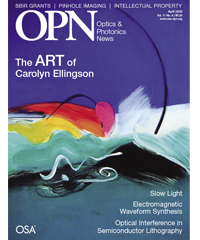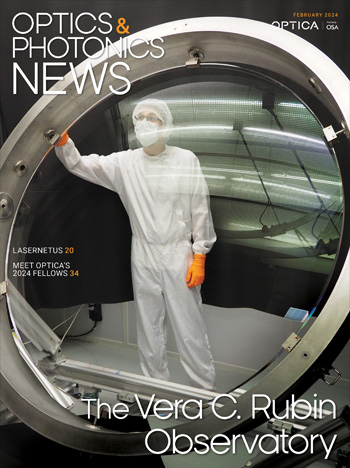
April 2006 Issue
Feature Articles
Applications of Slow Light in Telecommunications
Exotic effects such as slow light, fast light and even stored light have been observed in the laboratory. Now, optical scientists are turning their attention toward developing applications of slow light, including controllable optical delay lines, optical buffers and true time delay methods for synthetic aperture radar.
by Robert W. Boyd, Daniel J. Gauthier and Alexander L. GaetaUltrabroadband Arbitrary Electromagnetic Waveform Synthesis
Recent research leverages femtosecond arbitrary waveform generation (AWG) technology to achieve synthesis of arbitrary voltage waveforms in the range of 1 to 50 GHz. This capability far exceeds the 2 GHz frequency limitation of commercial AWG technologies.
by Jason D. McKinney, Ingrid S. Lin and Andrew M. WeinerUsing Destructive Optical Interference in Semiconductor Lithography
Integrated circuits—one of the greatest inventions of the last half of the 20th century—are still made using photolithography, even though their dimensions are now well below the exposure wavelength. Carefully tailored destructive interference is what makes it possible.
by Marc D. Levenson"Optically Induced Events" and Other Art by Carolyn Ellingson (Cover Story)
An artist who loved color, design and visual impact, Carolyn Ellingson held many concepts of spectral optics in high regard. Her artwork is filled with vivid, abstract images.
by Randy EllingsonDepartments and Columns
Producing Magnification without Lenses
Lenses do not appear to have been widely used in antiquity. Yet ancient artisans left behind a plethora of tiny works of art and engravings that could only have been made using magnification. Could “pinhole” technology be responsible?
Whose IP is it Anyway?
How to negotiate intellectual property rights ownership between businesses and their contractors.
Small Business Innovative Research Programs: Thinking Beyond Phase I
The U.S. government’s SBIR grant program is a great way for small technology companies in the United States to fund research and development of their innovative ideas. A good SBIR proposal is written not only with the intent of winning a Phase I award, but of going on to the subsequent phases of the program.
Early OSA Efforts in Optics Education
How did OSA evolve from a trade association of optical practitioners into a diverse group of scientists with a strong focus on education?

![A multiplexed image of a human tonsil acquired. [NIAID] using the iterative bleaching extends multiplexity (IBEX) method.](https://opnmedia.blob.core.windows.net/$web/opn/media/images/articles/2024/0424/departments/202404-cover-web.jpg?ext=.jpg)

